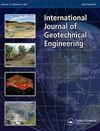Engineered water repellency for resilient and sustainable pavement systems
IF 1.3
Q2 ENGINEERING, GEOLOGICAL
International Journal of Geotechnical Engineering
Pub Date : 2023-08-01
DOI:10.1080/19386362.2023.2241280
引用次数: 0
Abstract
ABSTRACT Moisture-related pavement distresses lead to significant damage and recurring maintenance costs with substantial CO2 emissions. Engineering water repellency in pavement soils can help maintain uniform moisture conditions that improve and maintain performance, reduce design speculation, lowering material and construction costs, and emissions. This study examines the impact of grain size on water repellency treatment effectiveness. Soils from U.S. low volume roads and glass beads were treated with organosilane. Results showed effective water repellency, with contact angles ranging from 119.5° to 148.5°. Larger grain size reduced contact angle while increasing surface roughness raised it. Water drop penetration time tests showed no penetration after 2 hours (7200s), regardless of grain size, with breakthrough pressure values declining with larger grain and pore sizes (2kPa - 0.1kPa). This study discusses highlights the importance of considering grain and pore size effects when using water-repellent soils in pavement construction.工程防水性,适用于弹性和可持续的路面系统
本文章由计算机程序翻译,如有差异,请以英文原文为准。
求助全文
约1分钟内获得全文
求助全文
来源期刊

International Journal of Geotechnical Engineering
ENGINEERING, GEOLOGICAL-
CiteScore
5.30
自引率
5.30%
发文量
32
 求助内容:
求助内容: 应助结果提醒方式:
应助结果提醒方式:


